ウナギはどこで生まれるか、ご存じですか?
ウナギは日本の沿岸から何千キロも離れた海で卵を産み、命を終えます。
孵化した稚魚は長い旅を経て、日本の淡水域へと戻ってきます。
SPAC-静岡県舞台芸術センターの新たなプロジェクトでは、劇作家・石神夏希さんのもと、SPACの俳優と静岡に住むブラジルにルーツを持つ出演者たちが、この不思議な魚の旅をモチーフに演劇を通じて新たな物語を紡いでいます。
〜演劇は、自分が生まれるよりもずっと前に始まった物語を引き継ぐ、唯一の方法だ〜
◼️劇場から遠く離れた人々と劇場を作る
オープンスタジオの日が近づいてきたとある晴れた昼休み、私は演出家の石神さんに彼女の作品に対するアプローチについて話を聞くことができました。 石神さんは10年以上にわたり、日本国内外の村や都市の周縁など、劇場から遠く離れた場所や人々に向けて創作を行ってきました。舞台に立つことのない人々に「語る」機会を与えること。それが、彼女が創作に対して捧げる熱意なのだと知りました。
「演劇は自分に関係ない」と感じている人たちのもとへ、演劇を届けようとする石神さん。
私はこれまでの人生で出会ってきた、演劇の力によって変わった多くの人たちの顔が浮かべながら、彼女の言葉に何度も頷いていました。
私はまさにこういう場面に立ち会いたくて劇場でのキャリアを選んだのだと、あらためて感じた瞬間でした。
2022年からSPACで活動をしてきた石神さんにとってこのプロジェクトは、彼女自身が培ってきた演劇へのアプローチと、SPACが持つ稀有な創作環境、プロフェッショナルたちの力を融合させる新たな挑戦でもあります。
そんな石神さんは稽古の最初の段階から、チームメンバーひとりの個性や生活の背景に強く関心を持っていました。
そんな彼女は創作のはじめに、人生でもっとも重大な瞬間のひとつについて語り合う質問を問いかけました——「あなたの理想の死に方は何ですか?」
自分の「死」を思い描くこと。それは、自分自身の人生の軌跡を見つめ直し、取り戻すことでもありました。生まれる場所は選べないけれど、どこでどんなふうに終わりたいかを考えることはできる。少なくとも、想像することはできます。
「演劇は、人に語る力を与え、自分の人生を自分の言葉で紡ぐ機会をくれる。」
石神さんがそう語ったとき、私は大きくうなずいて微笑みました。
みんなが自分を見てくれて、話をちゃんと聴いてくれる場所―― そんな空間ほど「自分の居場所」強く感じられるものはありませんでした。
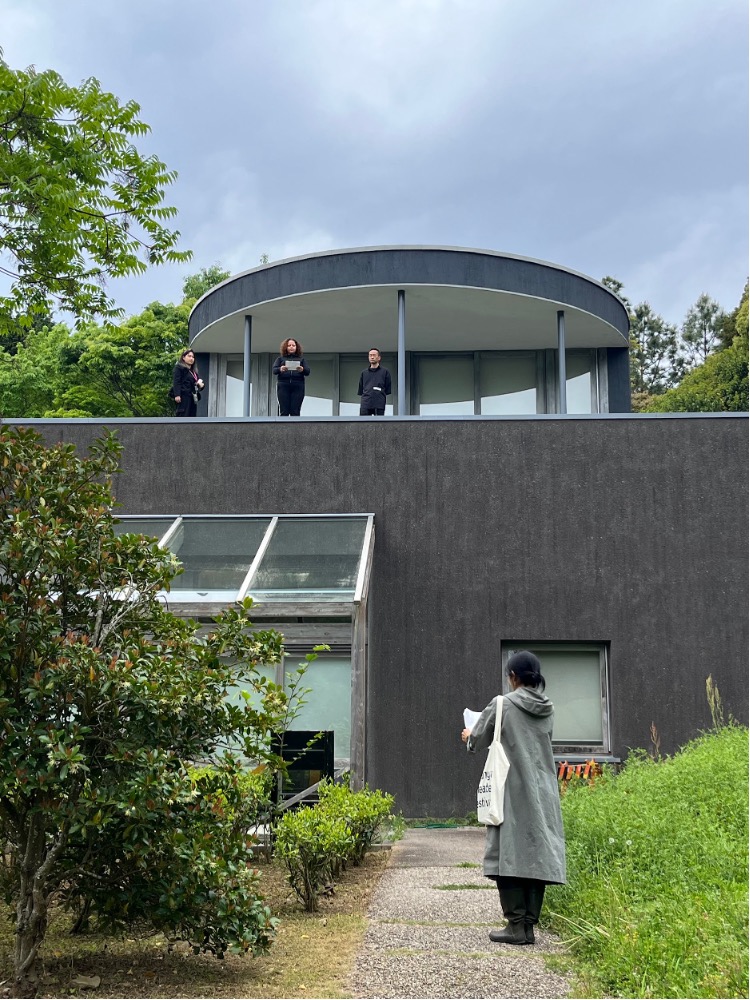
通常の劇場空間ではない場所のために作品を作る石神夏希さん
◼️浜松、ブラジル、そしてウナギ
『うなぎの回遊』チームと過ごした数週間は、芸術的・人間的に豊かな学びの経験であっただけでなく、特に想像もしなかったようなことについて日本をより深く知ることができました。 たとえば、日本の海洋生物学や移民政策が引き起こす人口動態の変化といったことは、観光ガイドにはまず載っていません。
ブラジルと日本の共通の歴史について全く知らなかった私は、このプロジェクトを通じて、20世紀初頭より、日本から多くの移民が労働力としてブラジルへ渡り、その後も世代を重ねて発展してきた日系ブラジル人の子孫たちが、現代の日本社会のなかで、言葉や文化の違いからくる生きづらさにも直面していることを知りました。彼らの多くが、浜松市近郊という静岡県内の工業都市のエリアに暮らしています。そして浜松は、うなぎの養殖でも全国的に知られた場所です。
私はうなぎを食べないので、それまでこの魚について知っていたのは「絶滅危惧種である」という程度のことでした。しかも思い浮かべるのは、私の故郷に生息するヨーロッパウナギのことだけ。 しかし日本では、うなぎは仏教文化ともつながりを持ち、何より食文化の中で非常に大きな役割を果たしているのです。日本は世界でもっとも多くうなぎを消費する国であり、甘い蒲焼きや寿司、白焼きなど、あらゆる調理法で食卓に登場します。そして、その供給を支えているのが、 浜名湖のうなぎ養殖場なのです。
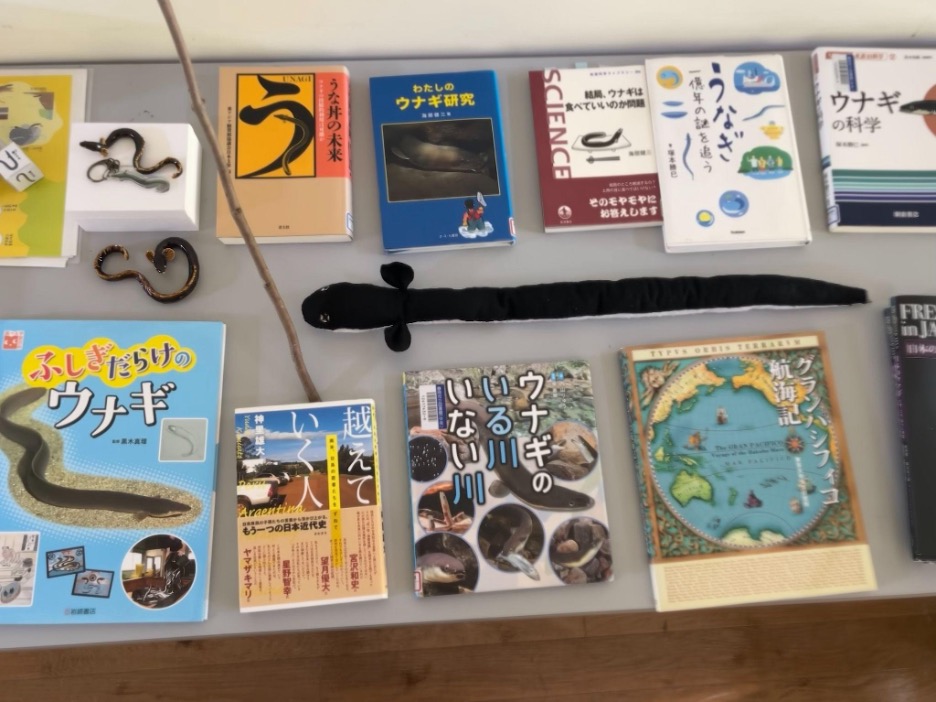
オープンスタジオのためにメンバーが集めた資料の数々
リハーサル室にある資料や書籍に目を通しながらこの土地の現実に触れていくうちに、このプロジェクトの寓意的な側面をますます理解するようになりました。 ウナギとブラジル人コミュニティを作品の中心に据えることで、科学的データや社会学的な現象としてではなく、固有の存在として、それぞれを生きる命として見つめる視点が開かれるのです。 両者はまるで織物のように重なり合い、浜松という場所を象徴する二つの存在が、それぞれの「起源」や「移動」をめぐる問いの中で絡み合っているかのようです。彼らがどれほど異なり、同時にどれほど似ているかに焦点を当てています。
私はすでに、演劇が人間社会に光を当てる重要な方法の一つであると信じていますが、動物そのものを主題にする演劇に出会うことはそう多くありません。だからこそ、私自身が動物の権利に日々関心を持つ者として、この劇をさらに応援したいと思いました。
■ 県民出演者たちとの出会い
数日間にわたるSPACチームとの準備を経て、ついに県西部から県民出演者たちがリハーサル場にやってきました。石神さんや制作スタッフは事前の面談ですでに面識がありましたが、私にとってはこの日が初対面です。会社員、主婦、自営業者などそれぞれに多忙なため、今回のオープンスタジオの稽古はわずか2日間で、限られた時間での挑戦でした。
それでも、ドアを開けた瞬間から、その場には笑顔とあたたかな空気が満ちていました。私たちは互いに自己紹介をします。日本語、ポルトガル語、英語——まさに「バベルの塔」のような多言語の空間。でも言葉の違いは問題ではありません。大切なのは「伝えたい」という気持ちです。
そして、言語以外にも、このリハーサル室で言葉を超えてつながるための最良の手段があります——それが、音楽です。
その日、音楽を担当する棚川寛子さんの提案で、稽古はボディパーカッションを使った名前覚えのゲームから始まりました。
トーンチャイムを鳴らす前に、まずは音と身体を通して、空間をあたためていく。
それは、互いに安心して声を出せる場をつくるための、大切な“最初の音”のように感じられました。
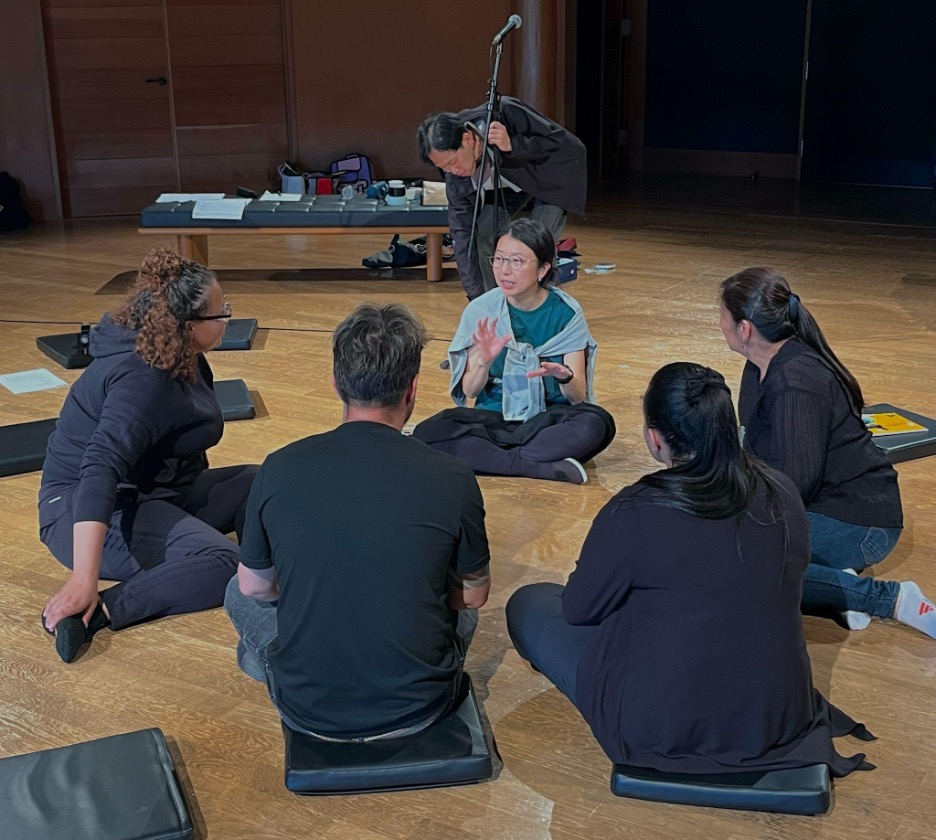
ブラジルをルーツにもつ県民参加者を稽古場に迎え入れる石神夏希さん
リハーサルでは、県民出演者全員が舞台づくりに関わり、自分のセリフや立ち位置を少しずつ覚えていきます。
中には演劇の経験がまったくない人もいますが、石神夏希さんはそうした背景にも丁寧に配慮しながら、やさしく見守ってくれます。
参加者たちは、自分の役割を誠実に、そして少しずつ自信を持って演じるようになっていきました。
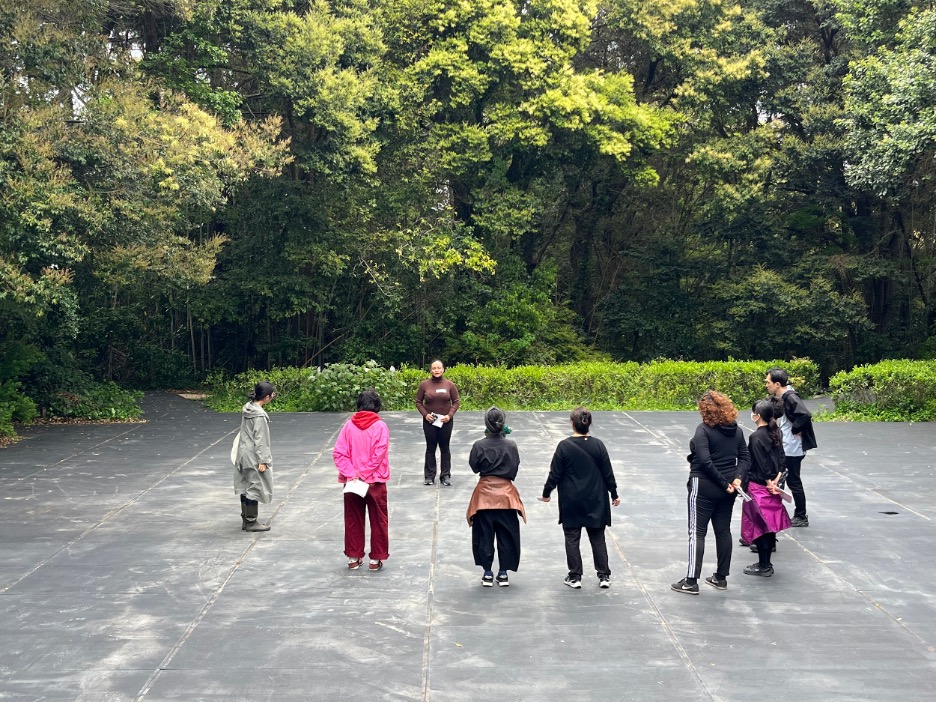
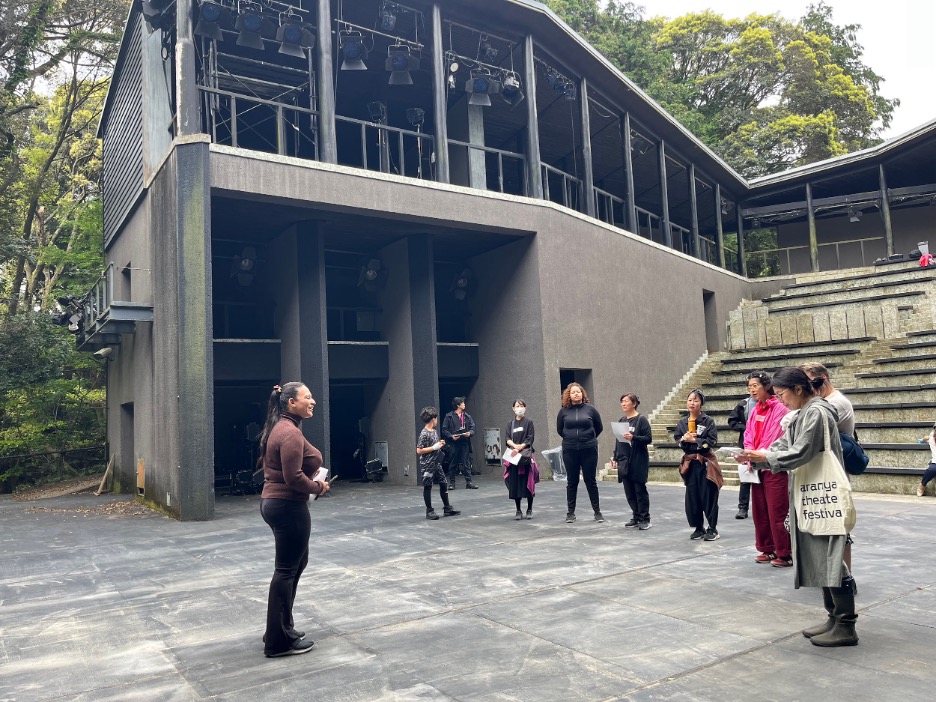
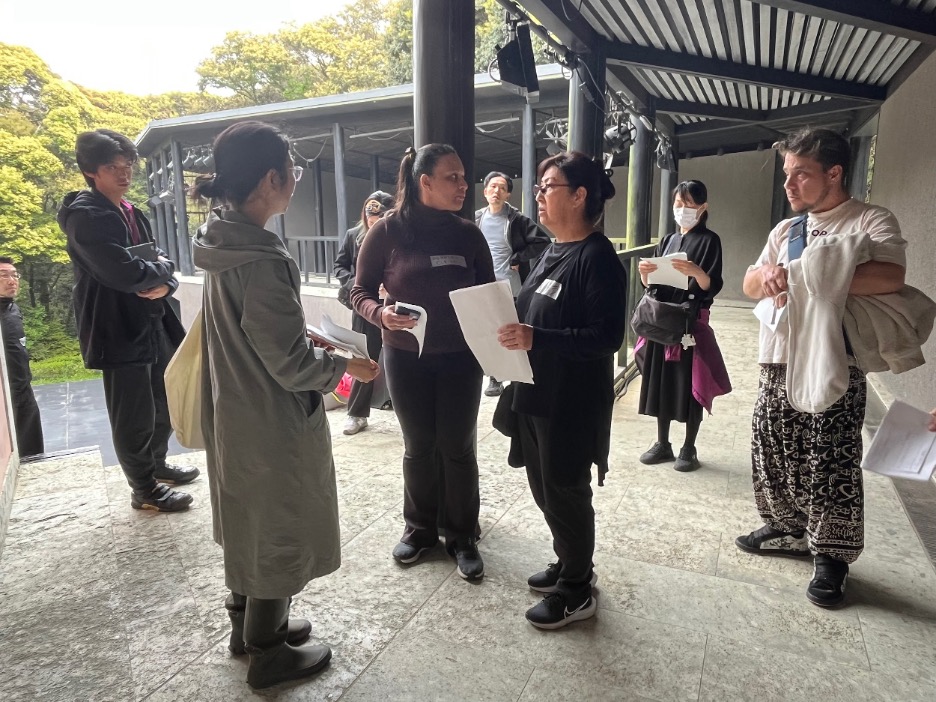
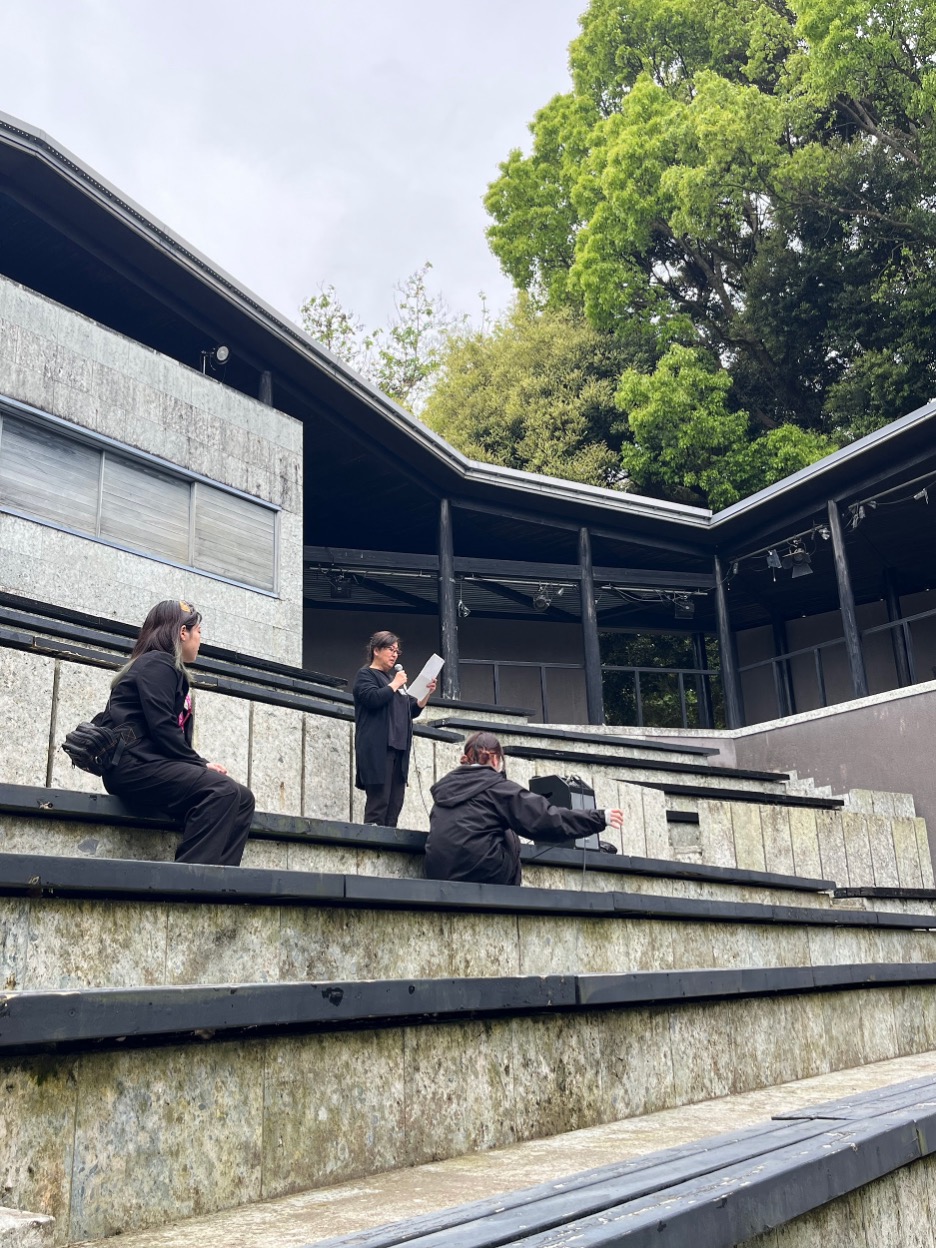
オープンスタジオに向けた稽古風景
リハーサルや休憩の時間を一緒に過ごすにつれて、雰囲気はますます遊び心がありながらも真剣になり、私たちの間には少しずつ信頼と親密さが芽生えていきました。互いの経験や希望を語り合い、音楽を鳴らし、ときに笑い合う。そうした時間の積み重ねが、誰もが安心して自分の居場所を感じられる空気をつくっていきます。 この「居場所の感覚」——自分もいていいんだ、語っていいんだ、という実感こそが、出演する皆さんにとって、オープンスタジオを通して得られた最も大きな手応えだったように思います。その詳しい話は、また次回。
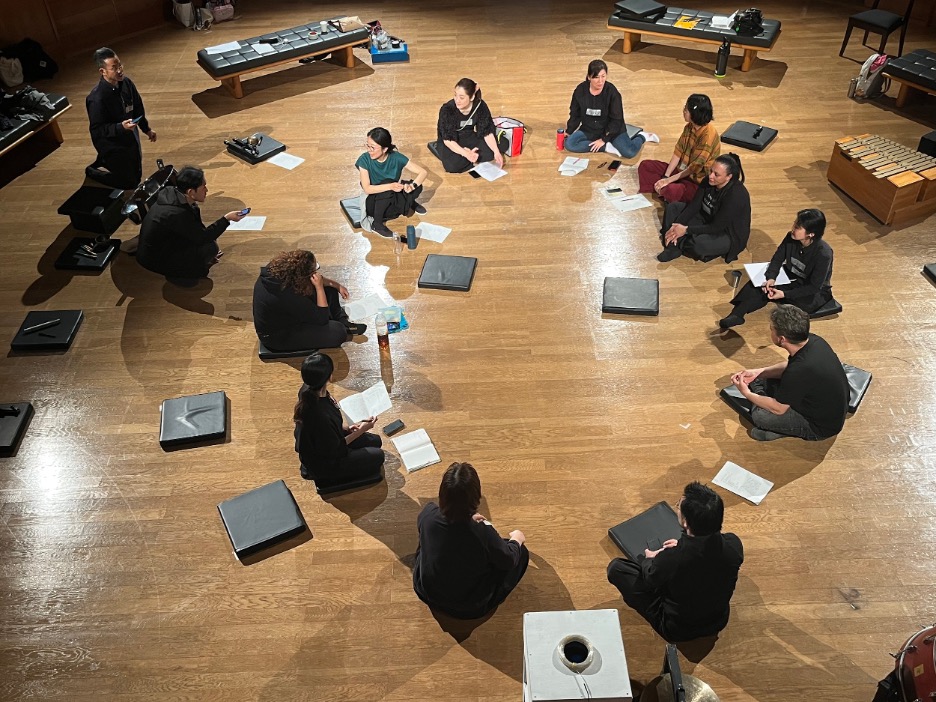
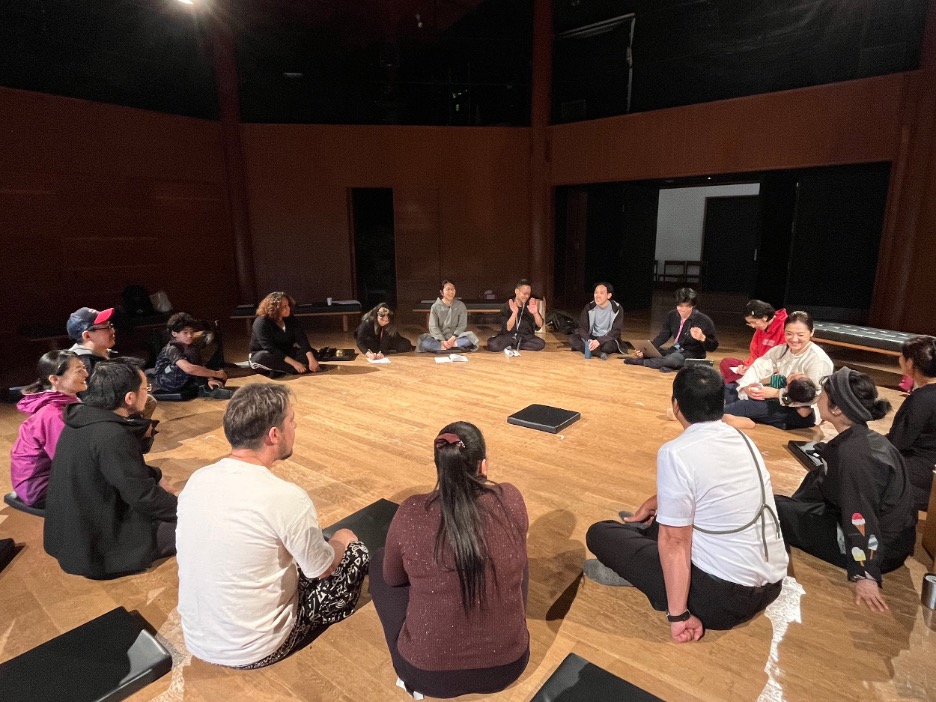
チーム全員でプロジェクトに関する活発な議論を交わしている様子
◼️自己紹介
こんにちは、私はエレーヌです。
フランスで5年ほどフランス国立の劇場でのスタッフとして経験を積んだ後、「自分を自由にする」ため、日本へやってきました。
SPACの皆さんに迎え入れていただき、石神夏希さんが演出され2026年春に初演を予定している『うなぎの回遊』の 創作初期に立ち会うという、かけがえのない2週間を過ごしています。
ENGLISH
FOLLOWING UP EEL MIGRATION
Part III : Meeting the Brazilian community
Have you ever wondered where eels are born?
Eels lay their eggs thousands of miles from the Japanese coast, and die once it pours out its seed. Once the baby eel is out of its shell, it travels back to Japan to live in the country’s fresh waters.
In this new project by the Shizuoka Performing Arts Center, director Natsuki Ishigami brings together actors from SPAC and non-professional actors with roots in Brazil who live in Shizuoka, to explore the fascinating journey of these fascinating 100-million-year-old fish.
‘Theatre is the only way to take up a story that someone else started long before I was born’
Making Theatre with Those Who Are Far from Theatres
As we are getting closer to the Open Studio date, I took advantage of a sunny lunch break to talk to the director Natsuki Ishigami about her artistic approach. For more than ten years, the playwright has dedicated her work to people and places that are far away from theater venues : from villages to urban suburbs, in Japan and around the world, she writes so she can give a voice to those who never come on stage to speak up. Her ambition: to bring theatre to those who feel far away from it. As I listened to her speaking, I nodded enthusiastically, thinking of all the people I have met throughout my career whose lives have been changed thanks to theatre – and that is exactly for situations and ideas like these that I wanted to work in a theater in the first place.
Since she has been collaborating with SPAC since 2022, Natsuki Ishigami knows how resourceful the place can be, and intends to combine her artistic approach with the talented professionals who work there to create a unique project. Since the very first roundtable, I sensed how important it is for her to take into account everyone’s one singularité, individuality and life story. When she started a project, the director systematically asked each of the project members : “How do you want to die ?”, initiating a discussion on one of the most intimate life moments. Picturing our own death is a way to reclaim our own life trajectory : we do not choose where our life begins, but we can decide, or at least imagine, how it could end. “Theatre gives people the power to tell their story and create their own life narrative,” concludes Natsuki Ishigami as I smile, agreeing with her : If you want to tell everyone how much you belong, what could be better than a space where everyone looks at you and listens to you ?

The director writing her play for unconventional outdoors spaces.
Hamamatsu, Brazil, and the Eels
The weeks that I spent with the Eel Migration team were not only enriching on a human and artistic level, but they also allowed me to get to know Japan better, especially on matters I would never have imagined. Actually, there are so many things to discover about this fascinating country that marine biology and demographic consequences of migrations policies are not front page topics in tourist guides. Even though I was completely unaware of the common past between Brazil and Japan, thanks to the project I learned about the integration difficulties and treatment inequality that the Brazilian community descending from mid-20th Japanese South America emigrants is facing everyday. This community mostly lives in Hamamatsu, an industrial coastal city in Shizuoka prefecture, also known for its eel production.
As I don’t eat eels myself, my knowledge of the animal was limited to its endangered species status – and when I am saying that, only thinking of the European Eel, the variety that lives in my home region’s rivers. In Japan, however, Eels hold a much bigger place in the society : they are a symbol in Buddhist culture, and especially prevalent in Japanese cooking, as Japanese are the world’s top consumers. Sweet cakes, sushi, grilled on rice, you can find Eel everywhere in the Japanese gastronomy, which relies on the productivity of eel farms in Hamamatsu that are renowned throughout the country.

Open Studio’s bibliography.
As I kept discovering Hamamatsu’s singularities and documenting myself thanks to the bibliographic resources available in the rehearsal room, I increasingly understood the allegorical dimension of the project. Putting eels and people with Brazilian roots at the heart of the artistic process allows everyone to acknowledge them as full life-beings, with their own existence, and to consider them for real, not as scientific or sociological data. Both are like weaved with each other as if these two Hamamatsu’s symbols were intertwined by the questioning of their origin, their migration, focusing on how they are so different and so similar at the same time. I was already convinced by how much Theater is an important way of putting light on human society, but it is hard enough to find a theater contemporary play that puts an animal as the subject of a contemporary play – and as a fervent advocate for animal rights, it is just another reason to support this play even more.
The arrival of the Brazilian-rooted participants
After several days of exchanges and rehearsals for the SPAC teams, it is time for us to welcome the amateur participants from Hamamatsu and western area of the prefecture, whom we can’t wait to meet. While the production team and the director already met them, it will be a first encounter for the rest of the team and myself. As they work as employees, stay-at-mothers, entrepreneurs, they all lead very busy lives, which is why we only meet two days before the first Open Studio of the Festival. From the moment they stepped through the door, everyone could see smiles and warm greetings all over the place. We all introduce ourselves, in a mix of languages worthy of the Tower of Babel but it does not matter because one could read behind the words all the excitement and the willingness to connect with each other. And besides language, music is the best way to communicate without words in this rehearsal room, as you already know : before picking up the tone chimes, Hiroko Tanakawa the music composer initiates a body percussion game to help everyone memorize the name and feel comfortable on stage.

The director is welcoming the Brazilian-rooted participants.
During the rehearsals, all the amateur participants take part in the setup and get to know their speaking parts, with the kind-hearted supervision of Natsuki Ishigami who takes into consideration the fact that some of them have never done theater before, and they all learn to play their own part with sincerity and confidence.




The Open Studio rehearsals
As we spent more time together during rehearsals and breaks, the atmosphere became
more and more playful yet studious, and everything felt comfortable enough to share their lives, hopes and experiences. I felt like a true community is being created here, where every member of the project belongs. This feeling of legitimacy and belonging was actually one of the strongest memories the participants had from the Open Studio, but I will tell you all about it in a future episode.


The whole team is actively discussing the project.
Who am I?
My name is Hélène, and after almost five years of experiences in theatre and national stages in France, I’ve come to Japan to lose – or find – myself. Welcomed by the SPAC teams for a few weeks,, I had the chance to follow the setting up of the Open Studio of the Eel Project, a SPAC creation scheduled for Spring 2026, directed by Natsuki Ishigami.
FRENCH
SUR LA ROUTE DU PROJET EEL MIGRATION
Partie 3 : L’arrivée de la communauté brésilienne
Vous êtes-vous déjà demandés où naissent les anguilles ?
Les anguilles pondent à des milliers de kilomètres des côtes japonaises, et décèdent une fois qu’elles ont frayé. Leurs petits, une fois sortis de leur coquille, font le trajet inverse pour revenir vivre dans les eaux du Japon.
Dans ce nouveau projet du Shizuoka Performing Arts Center, la metteur en scène Natsuki Ishigami réunit comédiens du SPAC et comédiens non-professionnels, ayant une attache avec le Brésil et vivant dans la préfecture de Shizuoka, dans un projet inspiré par le fascinant voyage de ces poissons symboliques, vieux de 100 millions d’années.
“Le Théâtre est la seule manière de reprendre une histoire que quelqu’un d’autre a commencée bien avant ma naissance”
Faire du Théâtre avec ceux qui sont loin des théâtres
Tandis que la date de l’Open Studio approche, je profite d’une pause déjeuner ensoleillée pour discuter avec la metteur en scène Natsuki Ishigami de sa démarche artistique. Depuis plus de dix ans, la dramaturge dédie son travail aux personnes et aux lieux éloignés des salles de spectacle : des villages aux périphéries urbaines, au Japon comme ailleurs dans le monde, elle écrit pour donner la parole à ceux qui ne la prennent jamais sur les scènes de théâtre. Son ambition : amener le théâtre à ceux qui s’en sentent éloignés. Tandis que je l’écoute parler, j’hoche la tête avec enthousiasme en pensant à toutes les personnes que j’ai rencontrées au cours de ma carrière et dont le théâtre a changé la vie – c’est exactement pour des situations comme celles-là que j’ai voulu faire ce métier.
Collaboratrice du SPAC depuis 2022, Natsuki Ichigami voit dans le projet Eel migration la possibilité d’associer sa démarche aux ressources uniques du lieu, riche de nombreux professionnels talentueux, pour créer un projet unique. Dès les premiers tours de table, je sens combien il est important pour la metteur en scène de prendre en compte la personnalité, l’individualité, les réalités de vie de chacun. Lorsqu’elle débute un projet, la metteur en scène demande systématiquement à chacun de ses participants : “Où est-ce que tu aimerais mourir ?”, initiant une discussion sur l’un des moments les plus intimes d’une existence. Imaginer sa propre mort, c’est se réapproprier sa trajectoire de vie ; on ne choisit pas où notre vie commence, mais l’on peut décider, du moins imaginer, comment elle se termine. “Le théâtre donne le pouvoir aux gens de raconter leur histoire, et de créer leur propre récit de vie”, conclut Natsuki Ishigami tandis que je souris, tant je suis d’accord avec elle : quoi de mieux qu’un espace où tout le monde vous regarde et vous écoute pour vous sentir légitime d’être au monde ?

La metteuse en scène affectionne particulièrement les espaces qui ne sont pas initialement prévus pour le théâtre.
Hamamatsu, le Brésil et les Anguilles
Pour moi, les semaines passées avec les équipes du projet Eel Migration n’ont pas été seulement enrichissantes humainement et artistiquement, elles m’ont également permises de développer ma connaissance du Japon sur des sujets que je n’aurais jamais imaginé. Et pour cause, il y a tellement de choses à découvrir dans ce pays fascinant, la spécificité de la biologie marine et les conséquences démographiques des politiques migratoires ne sont pas en première page des guides touristiques. Ignorant jusqu’alors totalement l’existence d’un passé commun entre le Brésil et le Japon, j’apprends les difficultés d’intégration et les disparités de traitement vécues par les communautés brésiliennes, descendantes de Japonais ayant émigré en Amérique du Sud au milieu du XXe siècle. Cette communauté réside majoritairement à Hamamatsu, une ville industrielle côtière, connue également pour sa production d’anguilles.
N’en mangeant pas moi-même, je ne connaissais l’anguille que par son statut d’espèce en danger d’extinction – et quand je pensais à l’anguille, je pensais à l’anguille européenne, celle qui peuple les rivières de mon département d’origine. Au Japon pourtant, l’anguille possède une place qui dépasse bien largement celle qu’elle occupe chez nous : important dans la culture bouddhiste, source de nombreux mystères, l’animal est surtout très présent dans les assiettes japonaises qui en sont les premiers consommateurs au monde. En gâteau sucré, en sushi, en grillades, il est un indispensable de la gastronomie du pays qui compte sur la productivité des fermes d’anguilles d’Hamamatsu, réputées dans tout le pays.

La bibliographie de l’Open Studio.
Petit à petit, tandis que je découvre ces réalités du territoire et me documente grâce aux ressources bibliographiques présentes dans la salle de répétition, je perçois de plus en plus clairement la dimension allégorique de la pièce. Mettre les anguilles, mettre les communautés brésiliennes au cœur du processus artistique devient une manière de les considérer comme des êtres à part entière, avec une existence propre, et non comme une donnée scientifique ou une réalité sociologique. Comme tissé l’un avec l’autre, le sort de ces deux symboles d’Hamamatsu vient se mêler l’un à l’autre en questionnant l’origine, la migration, et nos inévitables similitudes et différences avec le monde animal. En tant que fervente défenseuse de la cause animale, je suis ravie de faire cette plongée dans le monde des anguilles qui, comme beaucoup d’animaux, sont rarement mises à l’honneur comme sujet d’une pièce de théâtre contemporain – raison supplémentaire d’aimer autant le projet.
L’arrivée de la communauté d’origine brésilienne
Après plusieurs jours d’échanges et de répétitions pour les équipes du SPAC, il est temps d’accueillir les participants amateurs d’Hamamatsu que nous sommes impatients de rencontrer. Si l’équipe de production et la metteuse en scène les connaissent déjà, ce sera une première rencontre pour le reste de l’équipe et moi-même. Salariés, mères au foyer, entrepreneurs, ils mènent tous des vies bien chargées, c’est pourquoi le temps de répétition est très court pour cet Open Studio. Dès qu’ils franchissent la porte, les sourires sont immédiats et les salutations chaleureuses. On se découvre, on se présente dans un mélange de langues dignes de la Tour de Babel, mais cela n’a pas d’importance : l’excitation du projet se ressent chez tout le monde. Outre le langage, vous l’aurez compris, ici pour briser la glace, rien de tel que la musique : avant de prendre les tone chime, Hiroko Tanakawa initie un jeu de body percussion qui nous familiarise avec nos prénoms et l’espace scénique. Pendant les répétitions, tous prennent place dans le dispositif et se familiarisent avec leur prise de parole, sous les directives bienveillantes de la metteuse en scène Natsuki Ishigami, consciente que certains montent sur scène pour la première fois.

La metteur en scène Natsuki Ishigami guide et accueille les participants amateurs.




Les premières répétitions sur les lieux de l’Open Studio.
Tandis que nous passons beaucoup de temps ensemble, en répétitions comme en pauses, l’ambiance devient joyeuse mais studieuse, et nous apprenons chacun à mieux nous connaître. A mesure que nous partageons nos passions, nos espoirs et nos expériences, nous commençons à former une vraie communauté où chacun se sent en confiance, légitime de prendre sa place. Ce sentiment de légitimité et de confiance est d’ailleurs l’un des retours les plus marquants fait après l’Open Studio, mais ça, je vous en parlerai dans un prochain épisode.


Toute l’équipe est en pleine discussion sur le projet.
Qui suis-je ?
Je m’appelle Hélène, et après presque cinq ans à travailler en théâtre et scènes nationales en France, je suis venue me perdre au Japon. Recueillie par les équipes du SPAC pendant deux semaines, j’ai eu la chance de suivre la mise en place de l’Open Studio du projet Eel Migration, nouvelle production du SPAC prévue au Printemps 2026, dirigée par Natsuki Ishigami.